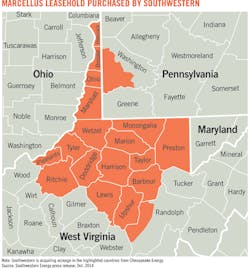Southwestern makes $5.4 billion bet on Marcellus
Rachael Seeley, Editor
Southwestern Energy Co. is purchasing Appalachian assets from Chesapeake Energy Corp. in a deal that more than doubles its leasehold in the Marcellus shale and grants it a foothold in an area of the play that is also prospective for the emerging Utica shale.
The $5.4 billion deal, announced in mid-October, will bring Southwestern 413,000 net acres in southwest Pennsylvania and the West Virginia Panhandle.
"This is great rock and it's got enough wells in it to show it's good rock," Southwestern Chief Executive Officer Steve Mueller told an investor presentation. Development will initially focus on the Marcellus because it is better understood. But, Mueller said, "I think there are a lot of good surprises there."
Southwestern is set to acquire 435 horizontal wells and 1,100 legacy wells with proved reserves of 221 million boe. September production totaled 184 MMcfd of gas, 20,000 b/d of NGL, and 5,000 b/d of condensate.
The purchase more than doubles Southwestern's Marcellus well count and extends the company's reach into a new area of the play. Until now, its Marcellus leasehold was concentrated in northeast Pennsylvania.
The company has drilled more than 300 wells in its existing acreage position, which spans 292,000 net acres. A recent investor presentation shows another 73 to 77 operated horizontal wells were slated to be drilled in the area this year, mostly in Bradford and Susquehanna counties.
Southwestern was already working to raise its Marcellus production. Last year, the company added 162,000 net acres to its northwest Pennsylvania position. Third-quarter production was up 47% from the prior year, at 717 MMcfd.
The acquisition adds a second core Marcellus operating area to the company's portfolio.
The sale does not represent an exit from Appalachia for Chesapeake. The company has retained all of its leasehold in neighboring Ohio, where it is aggressively targeting the Utica shale (UOGR Jul.-Aug. 2014, p. 20).
Utica potential
During the question and answer portion of the Southwestern's presentation, Charles Meade, an analyst with Johnson Rice, said recent tests in the deeper Utica have been drilled near the acquisition area.
Mueller said the company took the Utica's potential under consideration when it evaluated the acreage.
"Certainly the Utica on this acreage has not had many tests on it, but, as you [Meade] said, there's a lot of very exciting tests around the acreage, and so it was part of the evaluation," Mueller said.
Scott Hanold, an analyst with RBC Capital Markets, highlighted the Utica potential in a research note to investors.
Hanold said three recent industry tests near the acquisition area yielded strong initial production rates. Chesapeake recently completed its first horizontal Utica well on the West Virginia leasehold. The James WTZ No. 3H-U in Wetzel County, was not yet onstream at the time of the merger announcement.
"The dry-gas Utica shale is a potential game changer, but [it] is very early in its assessment," Hanold said.
Chesapeake had identified 165,000 net acres prospective for the Utica on the acreage being sold, but its Utica exploration and development program had focused on the liquids-rich portion of the play in eastern Ohio.
Contrarian gas bet
Southwestern is making a multibillion-dollar bet on natural gas at a time when many independent producers, like Chesapeake, Bill Barrett Corp., Encana Corp., and Newfield Exploration Co., are selling gas assets in favor of focusing on plays rich in oil, condensate, and NGL.
"We believe in a robust future for natural gas and we're developing an industry-best portfolio of properties to take advantage of that upside," Mueller said. "I think many out there and many in our industry in particular have been missing some of the signals. We've already evidenced the beginning of a new demand growth in 2014."
Weak gas prices in the US are spurring demand growth in the form of new industrial projects and LNG export terminals. Gas is also gaining market share as a feedstock in the power generation sector.
Michelle Foss, chief energy economist at the University of Texas Center for Energy Economics, expects a draw on US gas from new industrial customers will arrive by 2016 when projects come online along the Gulf Coast.
By 2030, Foss forecasts, total US gas demand will rise to 40 bcfd, from 28 bcfd now.
"In these gas markets really small changes in supply and demand exert a high influence on prices," Foss told an August presentation to the Unconventional Resource Technology Conference in Denver.
For now, Mueller said, market fundamentals support a $4/Mcf gas price. "We believe that a strong company can make great returns in that environment," Mueller said.
Rigging up
Southwestern produced 2.1 bcfd in the second quarter. Investor materials show the company is the fourth-largest gas producer in the US Lower 48, after ExxonMobil Corp., Chesapeake, and Anadarko Petroleum Corp.
Most of the company's production comes from the Fayetteville shale, which produces 1.4 bcfd, but the company believes it is well positioned to increase production from its newly acquired acreage. Chesapeake had one rig working there at the time the sale was announced.
The new leasehold is expected to supply a 20-year drilling inventory for an 11-rig program.
Hanold said a shortage of gas processing plants and pipelines would limit near-term production growth, but bottlenecks are expected to improve.
Southwestern is assuming a portion of Chesapeake's firm transportation and processing capacity commitments. Chesapeake will transfer 140 MMcfd of firm pipeline capacity to Southwestern, increasing to 340 MMcfd in 2017 with the start-up of Energy Transfer's Rover Pipeline.
Mueller was confident that capacity would be sufficient to support the company's drilling program.
"Rest assured that the five-rig program that we're talking about next year, we're very comfortable that we have the capacity to handle that, and we're very comfortable that we either have, or will have, the capacity to go to that larger rig program in 2017," Mueller told analysts.
Vertical integration
Southwestern has reduced costs in the Fayetteville shale in Arkansas, where it is the largest producer, by owning rigs and equipment, and it expects to apply that same strategy to the newly acquired Marcellus acreage.
"You can expect that we will vertically integrate very quickly," Mueller said.
The company is adding seven new, more-efficient rigs to its Fayetteville drilling fleet. The additions are part a vertical integration effort that saved the company an average of $437,000/well, or 15% of total well cost, in the shale play during the second quarter (UOGR Sep.-Oct. 2014, p. 26).
Mueller said a number of Fayetteville rigs were being upgraded in preparation for sale, but the company may now retain them and put them to work in the Marcellus.
"We can scale up with some of our equipment very quickly, and we're already looking at how we might do more than just the rig component," Mueller said. "I think over the next 12 months, once we get into it, you'll see significant vertical integration in this overall process."
Waiting period
Before the Marcellus deal can close, it must receive approval from the co-owner of Chesapeake's acreage, Statoil ASA, of Norway.
Statoil signed a $3.4 billion joint venture agreement with Chesapeake for the leasehold in November 2008. Statoil could decide to use its preferential rights to purchase the acreage instead. It had 30 days from the day of the initial announcement to exercise this option.
"What that means is they have 30 days to decide if they want to buy this acreage for the $5.4 billion," Mueller told analysts.
The company was not expected to utilize the option.
Mueller expressed confidence that the deal would close. "I'm very excited and the whole company is very excited about this acquisition. It fits who we are and what we do best," he said.


